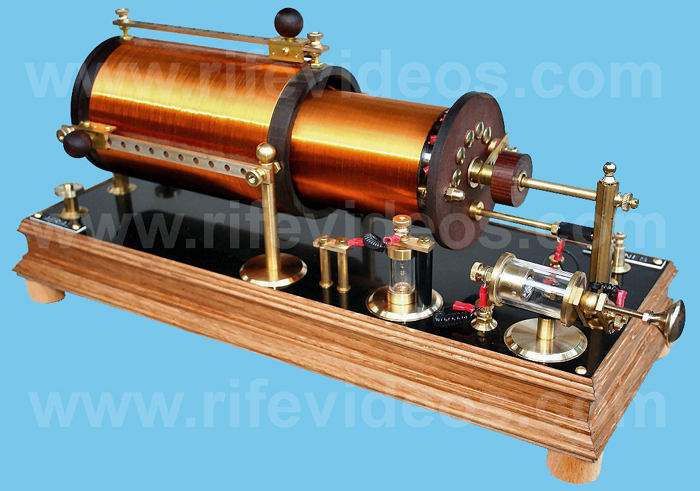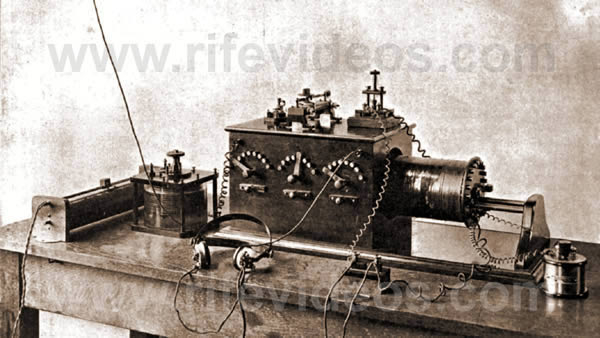| Home | Accessory Kit | Marsh CD Collection | Library | Contact Us |
Chapter #6
Dr. Rife's 1920 to 1922
Rife Ray #1 Rife Machine
1. Used a Ray tube.
2. The frequency range was probably about 1 MHz or less using loose couplers: Could modulate audio frequencies.
3. The output to the Ray tube was 8 to 10-watts.
From information taken from many different documented sources, there is finally enough information to know what Dr. Rife did in the early years, from 1920 to about 1934. Dr. Rife designated his machines in numerical order beginning with the Rife Ray #1. Even though we do not have any photos of his Rife Ray #1, we know that Dr. Rife was using loose couplers (photo shown above is a loose coupler) because of this statement:
RIFE: “Initially I worked with loose couplers to get an audio oscillation and then with the use of transmitters, I tried to balance the audio and modulate the audio on a carrier wave to transmit the audio energy.” (Dr. Rife’s 1961 Deposition, question and answer #35)
In a paper that was written in the 1930s, probably by Jack Free, one of Dr. Rife’s lab assistants, we get a history of Dr. Rife’s machines. This paper starts with the Rife Ray #1. We Quote:
"In January 1920 experiments were started at the Rife Research Laboratory by Commander Royal R. Rife U.S.N. Ret. to determine the effect of electrical influences upon pathogenic microorganisms. Tests were made for anode and cathode polarity influences and the effect of infrared, ultraviolet and X-ray. During these experiments the idea was conceived of the possibility of devitalizing the pathogenic micro-organisms by electrical frequencies of varying wavelengths.The initial apparatus (Rife Ray #1) for the tests along this line of experiments was constructed and used in prolonged experiments during 1921 and 1922, with results that warranted the belief that the principles involved contained possibilities." (Development of The Rife Ray and use in devitalizing of pathogenic microorganisms).
The tests that were done with the Rife Ray #1, which showed that it was possible to devitalize micro-organisms with frequencies, was talked about in a 1938 Evening Tribune newspaper article. Also in this newspaper article, we learn the power output of the Rife Ray #1 and the first organism that he was able to devitalize. We quote:
"Rife built a simple frequency generating apparatus of about 8 or 10-watts output. He grew some cultures of bacteria. Then he began the studies whose reported results now promise to revolutionize the entire theory and the whole treatment of the human diseases, other than those of a functional or accidental nature. Machine and cultures ready, the San Diegan anxiously, feverishly began testing his idea. Would those minute killers of men die under the frequency bombardment? It would be a patience-wracking task, for there was no way to measure what wave length or frequencies the organism might have. In the quiet loneliness of the laboratory, Rife simply had to turn and turn and turn the tuning dials of his machine and check after each bombardment the conditions of the disease organisms in his cultures to see if anything had happened to them. He just had to hunt by trial and error a frequency, which might do something to a certain organism. Then, if he found one for that disease, he would have to start all over again on the next kind.
The scientist took first a culture of b. coli, the organisms, which always seem to accompany the agency of typhoid fever yet apparently, are harmless themselves. He prepared microscope slides from the culture and saw that his little subjects were alive. Then he turned the ray on them, tuned it to a certain frequency, then took the slide back to the microscope to see if anything had happened. He did this time after time and the b. coli still remained discouragingly healthy. Then one day, Rife recounted, a culture of the organisms which had been bombarded with a certain frequency [417,000 hertz] appeared different under the microscope. They seemed lifeless! He tried to get them to grow, to reproduce in their laboratory media. He tried that same frequency on culture after culture of b. coli and always the results were the same. The organisms were dead. "It did kill them!" Rife told himself. And probably, cool, conservative scientists though he is, he allowed himself to hope that he, Royal Raymond Rife, had found that 'bullet" which scientist have sought for years, that "magic bullet' which would surely, certainly slay mankind's diseases." (Dread Disease Germs Destroyed By Rays, Claim Of S.D. Scientist-Cancer Blow Seen After 18-year Toil by Rife, The Evening Tribune, May 6, 1938)
These few statements that we have just read give us all that is really known about the Rife Ray #1. The most important development that was accomplished with the Rife Ray #1 was Dr. Rife was able to test and prove that microorganisms could be killed or devitalized using RF frequencies pulsed with an audio frequency.The photo, shown below, is a picture of a more complex loose coupler setup.
By 1923 Dr. Rife assembled his next Rife Machine called the Rife Ray #2 using off-the-shelf frequency generators. The same equipment that was used with the Rife Ray #2 was also used with the Rife Ray #3. The changes made to the Rife Ray #2 to create the Rife Ray #3 appear to be mostly an increase in the power output of the instrument through the ray tube. Since the full details of the changes are not known and the same equipment that was used with the Rife Ray #2 was used with the Rife Ray #3 we will look at to the Rife Ray #3 in the next chapter.
Chapter Summary: The Rife Ray #1 was a simple frequency generating device built to determine if microorganisms could be devitalized by frequencies. The instrument was built using loose couplers which when moved in and out of the coil would produce different electrical RF frequencies. Dr. Rife modulated an audio frequency on the RF frequency he was using in order to produce a pulsed waveform. With this simple frequency generator, he was able to devitalize his first organism which was B. Coli. Dr. Rife after proving his theory went on to build more powerful equipment which we will look at in succeeding chapters in this report.
In chapter 7, we will discuss Dr. Rife’s Rife Ray #3 instrument that was used in the 1934 cancer and tuberculosis clinic which Dr. Milbank Johnson conducted.


